IDEX Online Research: Deflation Hits U.S. Jewelry Industry in May
June 25, 12
(IDEX Online) – Both supplier jewelry prices and retail jewelry prices fell in May 2012, when compared to April. Suppliers’ jewelry prices fell by 0.8 percent, while retail jewelry prices fell by 1.6 percent, when measured against the prior month.
Further, all sub-components of inflation – including individual jewelry, watch, and precious metal jewelry as well as key commodity components including diamonds, gold, silver, and platinum – declined in price during May, when compared to April price levels.
This is the first month in years that all components of jewelry inflation have fallen on a month-to-month basis.
On an annual basis – comparing May 2012 versus May 2011 – supplier jewelry prices are still up from last year, but at only a single digit level. Retail prices in May dropped to levels below last year. Further, except for a couple of anomalies late in the last decade, this is the first time that retail jewelry prices have fallen on a year-to-year basis since 2005.
The moderating inflation trends are primarily the result of the lack of inflation this year for polished diamonds and precious metals. In addition, there has been some weakness in consumer demand for jewelry. April jewelry sales were almost flat versus last year, though it had much more to do with the timing of Mother’s Day sales than a sudden drop in consumer demand. Still, an unusually large number of uncertainties – high unemployment, a weak economy, geopolitical saber rattling, have bombarded shoppers and the vitriol associated with the upcoming presidential election. When consumers feel uncertain about the future, they tighten their purse strings.
Jewelry Wholesale Prices Soften in May
In May, the Jewelry Producer Price Index (JPPI) stood at 215.1, down notably from April’s 216.9. A year ago, the JPPI stood at 197.3. Here is what this data means:
· Wholesale jewelry prices dropped 0.8 percent on a month-to-month comparison basis: May versus April 2012.
· Wholesale jewelry prices rose by about 9.0 percent on a year-to-year comparison basis: May 2012 versus May 2011. This inflation rate is down notably from the double-digit inflation rates in the first quarter of 2012, and it is the first single-digit increase in a year and a half.
· Wholesale jewelry prices were up 11.9 percent for the five months year-to-date 2012 versus the same period a year ago.
· The graph below summarizes the JPPI over the past two years.
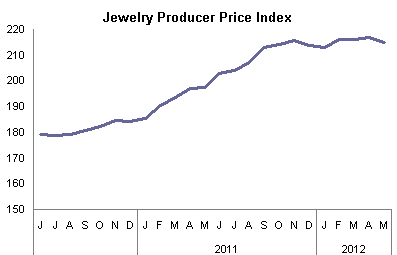 Source: BLS |
Jewelry Retail Prices Deflate in May
In May, the Jewelry Consumer Price Index (JCPI) stood at 164.5 versus April’s 167.1. A year ago, the JCPI stood at 164.9. Here is what this means:
· Retail prices of jewelry dropped by about 1.6 percent on a month-to-month comparison basis: May versus April 2012.
· Retail jewelry prices declined by 0.2 percent on a year-to-year comparison basis: May 2012 versus May 2011. This is the first year-to-year decline since 2005, except for a couple of anomalies in the past six years.
· The graph below summarizes the JCPI over the past two years:
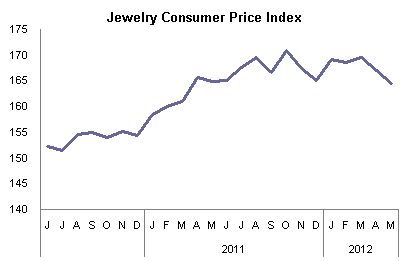 Source: BLS |
Deflation Detail
The table below provides detailed inflation / deflation rates for jewelry components as well as inflation rates at various levels of the jewelry distribution channel in the
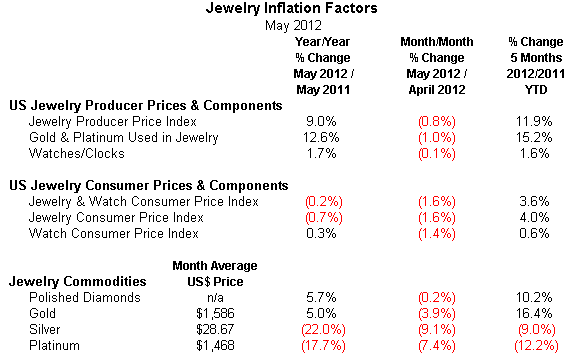 Source: BLS |
Jewelry Suppliers’ Price Inflation Moderating
May’s jewelry supplier price inflation rate of 9.0 percent, year-to-year, was above 2011’s inflation rate of 13.9 percent, but was about in line with the jewelry supplier inflation rate of 9.3 percent for the full year 2010, and it was well above 2009’s supplier inflation rate of 3.3 percent. However, it reflected a deflationary trend on a month-to-month basis.
After five months of 2012, jewelry supplier price inflation is up by 11.9 percent, a rate that has been slowing this year.
The graph below summarizes year-over-year jewelry supplier price inflation.
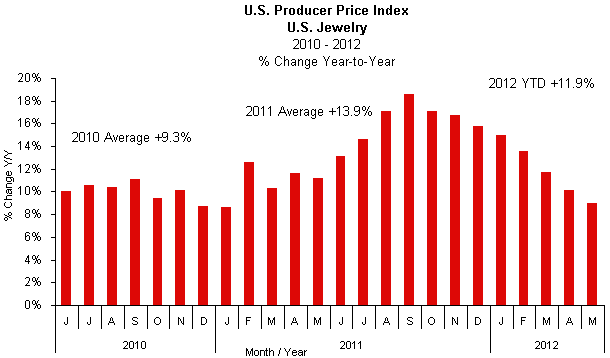 Source: BLS |
Higher Precious Metal Prices Continued to Drive Inflation Pace
Jewelry suppliers’ prices of precious metals jewelry rose by 12.6 percent during May 2012 versus the same month a year ago. While this was notably above jewelry suppliers’ overall inflation rate for all jewelry and watches of 9.0 percent for the month, it reflects the sixth consecutive month that precious metals price inflation has cooled.
On a month-over-month basis, jewelry suppliers’ prices for precious metal jewelry fell by 1.0 percent in May versus April 2012. On an annualized basis, this would suggest that suppliers’ jewelry prices could fall by 12 percent or so. Last month (April 2012), month-to-month prices indicated a 3-4 percent inflation rate, rather than deflation of 12 percent, as May’s numbers suggest. These unrealistic monthly swings illustrate why IDEX Online Research does not put much emphasis on monthly price changes: they simply are not meaningful.
The graph below compares the jewelry supplier inflation rate for precious metals jewelry (gold columns) versus the overall jewelry supplier inflation rate for jewelry (red columns). These comparisons are year-to-year.
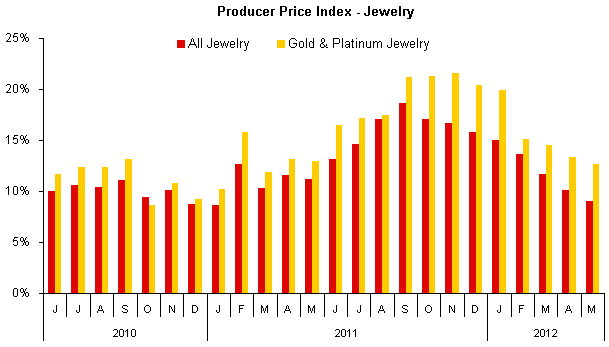 Source: BLS |
Watch Price Inflation Steady for Past Nine Months
Watch prices at the supplier level in May showed a moderate gain – +1.7 percent – when compared to the same month a year ago (May 2011). This level of inflation is reminiscent of inflation trends in 2009 and early 2010, when watch prices rose by a low single-digit level at the supplier level.
On a month-to-month basis – May 2012 versus April 2012 – supplier prices of watches were down only slightly by 0.1 percent. After five months of 2012, watch prices are up a modest 1.6 percent year-to-date.
In recent months, watch demand and watch sales in the
The graph below shows year-to-year supplier price inflation for watches for the past twenty-four months.
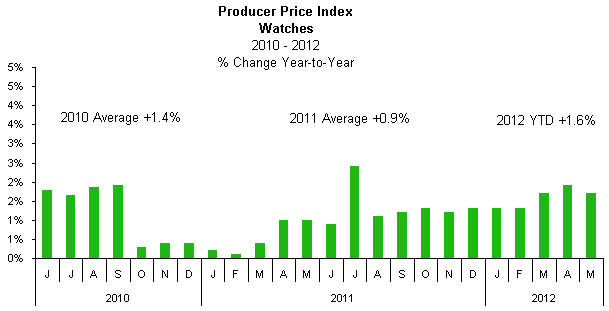 Source: BLS |
Retail: Jewelry and Watch Prices Fall in May
Jewelry and watch retail price inflation has been moderating since the third quarter of 2011. In May, retail jewelry prices experienced deflation on both a month-to-month basis and a year-over-year basis. Year-over-year prices were down 0.2 percent at the retail level. We think this may be due to recent muted consumer demand for jewelry.
On a month-to-month basis, retail jewelry and watch prices in May were down 1.6 percent, when comparing May 2012 to April 2012. Comparing the first five months of 2012 versus the same five-month period last year, retail jewelry prices are up by just 3.6 percent.
The graph below summarizes year-to-year retail jewelry price inflation in the
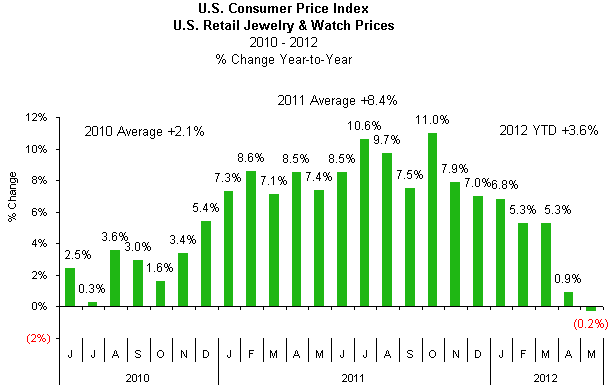 Source: BLS |
Retail Watch Prices Show Moderate Inflation in May
Retail and supplier prices of watches historically have tended to move together, on both a month-to-month basis and a year-to-year basis, over the past few years. However, in May, retail watch prices showed little price inflation while suppliers’ watch prices rose notably. Watches tend to carry an inherently lower margin than other jewelry merchandise categories, so this inflation trend is squeezing retailers’ margins further.
For the month of May 2012, retail watch prices rose by a miniscule 0.3 percent from May 2011. This is slightly below recent monthly comparisons of year-over year prices. Watch prices fell by 1.4 percent, when comparing May to April 2012 prices.
Retail Jewelry Prices Show Deflation in May
Retail prices of jewelry, excluding watches, were down 0.7 percent in May 2012, when compared to May 2011 prices. This is a dramatic decline from prior months. They were down 1.6 percent, when comparing May 2012 to April 2012.
The graph below compares the inflation rate for jewelry and watches (green bars), jewelry only (red bars), and watches (gold bars).
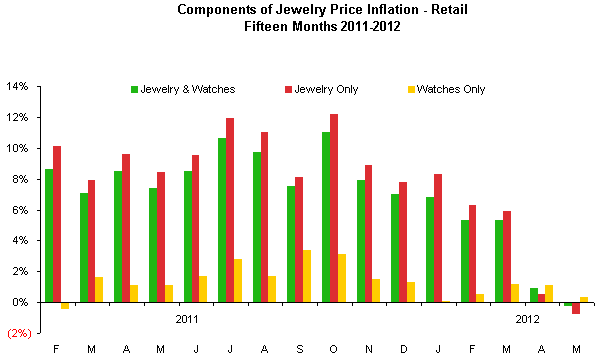 Source: BLS |
Jewelry Inflation Outlook: Moderating Inflation in 2012
Our outlook for jewelry price inflation remains unchanged: jewelry prices are expected to move higher at all levels of the distribution channel throughout 2012 and perhaps beyond. However, the rate of inflation is expected to be well below 2011’s torrid pace, both at the supplier level and at the retail level.
It would be easy to forecast inflation for the jewelry industry if all of the commodities involved in the forecast were used exclusively by the jewelry industry. While that may be the case for polished diamonds, precious metals are used by a number of other industries. Further, gold is an international currency that plays in a financial arena of its own.
· Jewelry Industry Long Term Outlook – Demand from emerging economies such as
· Global Economic Outlook for 2012 – The latest OECD data points to moderate economic growth with a “positive” outlook for stronger growth in the next 12-18 months. However, there is some divergence among the growth of certain economies, especially given the current fiscal problems in
· Financial Markets Outlook for 2012 – With continued volatility in the world’s stock markets and uncertain valuations related to stocks, bonds and other hard assets, investors may seek the safe haven that gold offers. Despite predictions by others that gold will hit $2,000 this year, we are not ready to embrace those forecasts. This level would represent a mid-teen price increase. We see investor movement toward income-producing assets, and a move away from assets that do not produce income or an inflation hedge, such as gold.
The bottom line: inflation is headed higher over the longer term, but perhaps at a more moderate rate. Jewelry suppliers and retailers should use periods of weakness in commodity prices to add to their inventory.